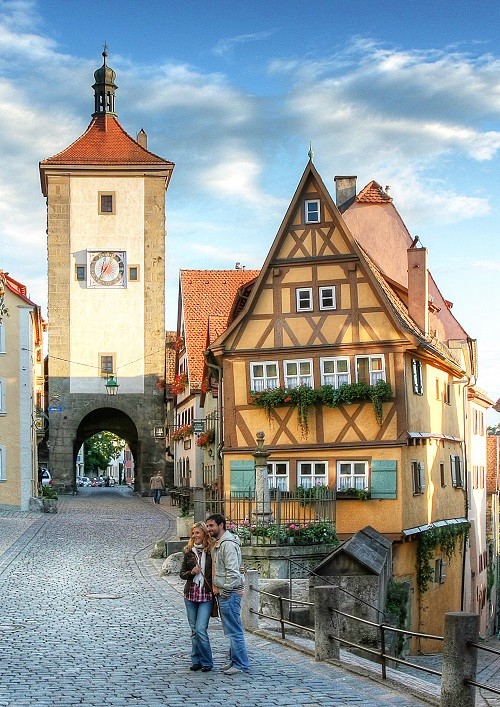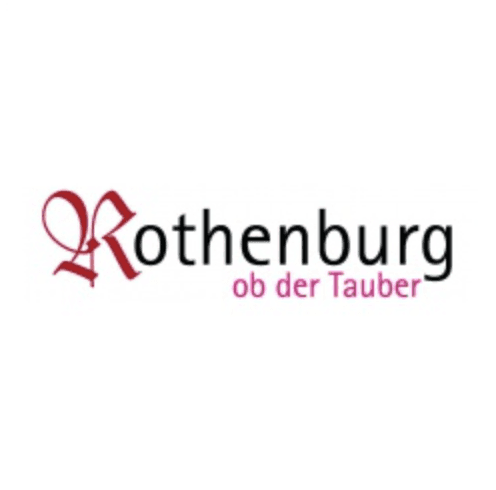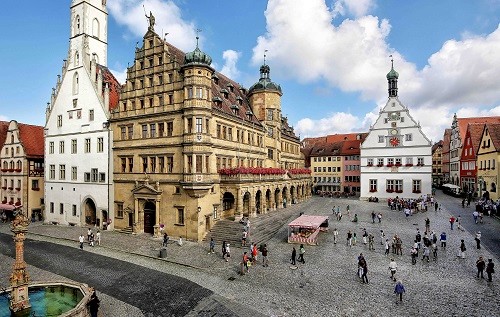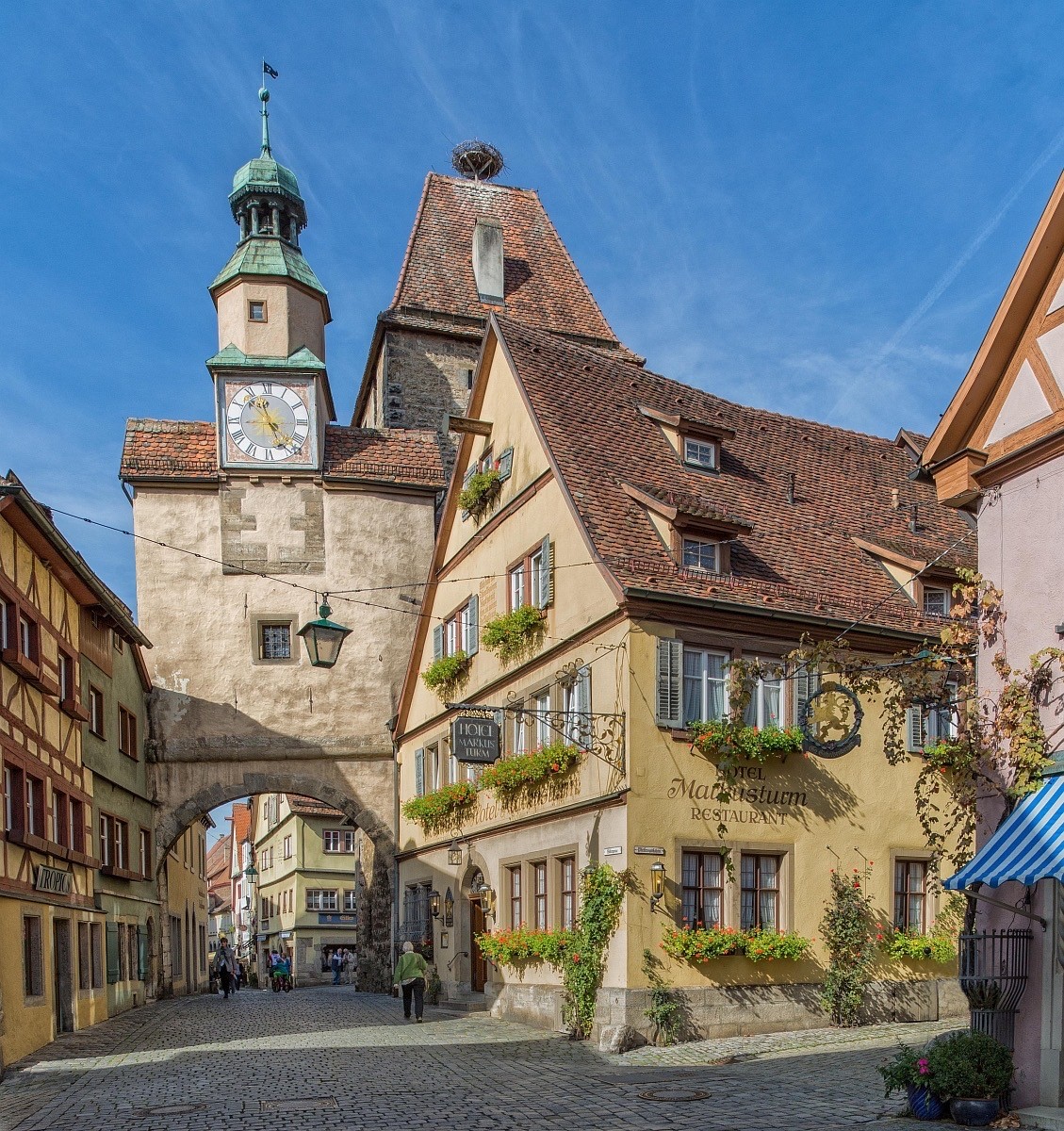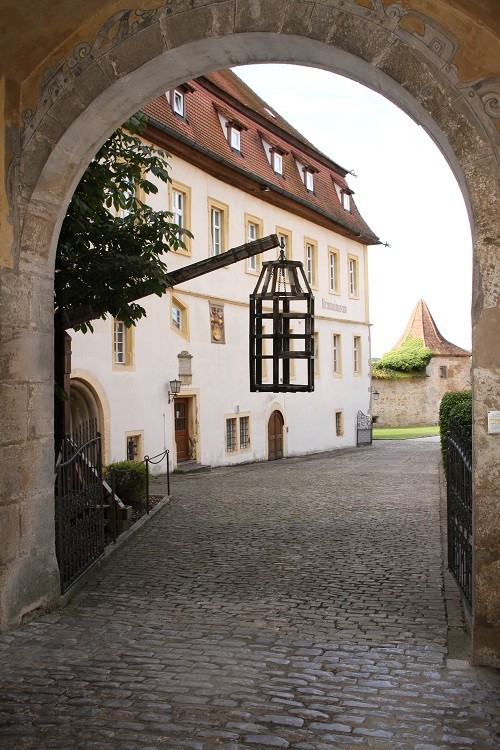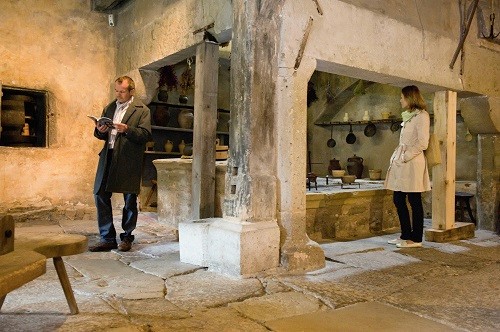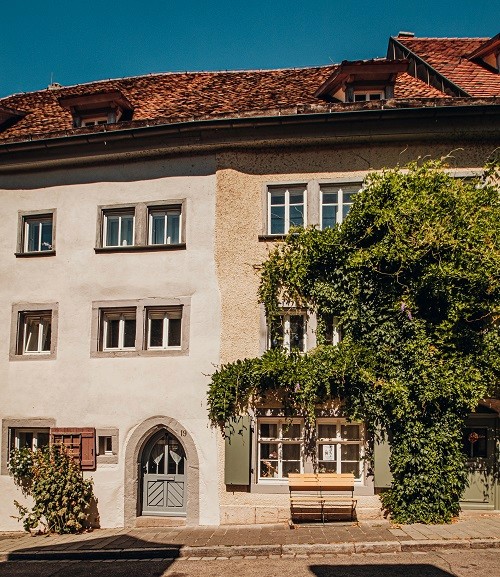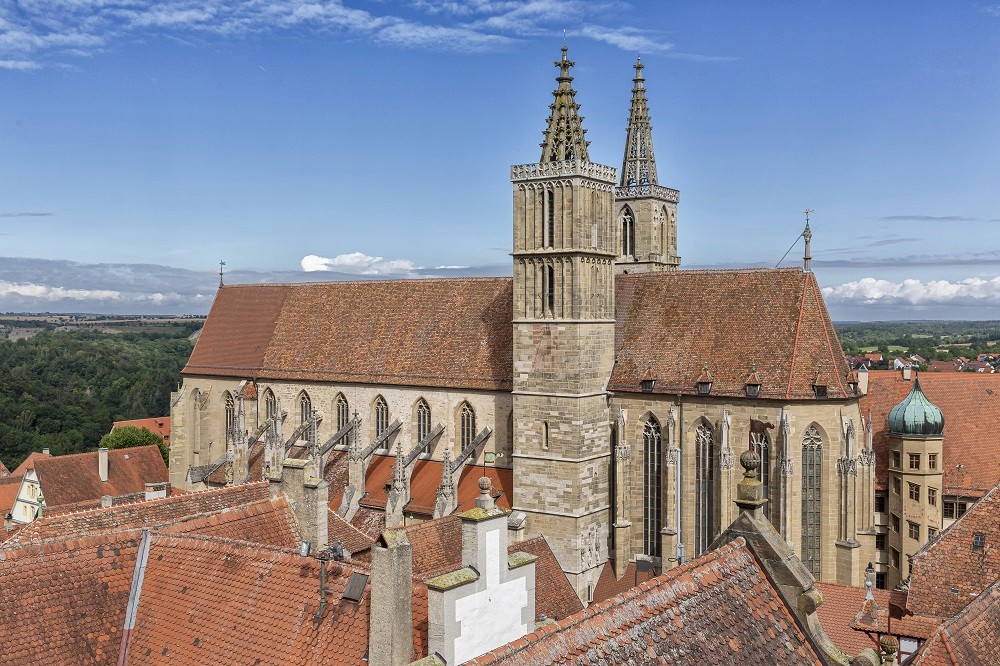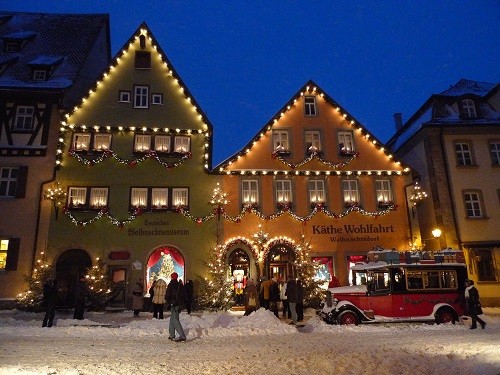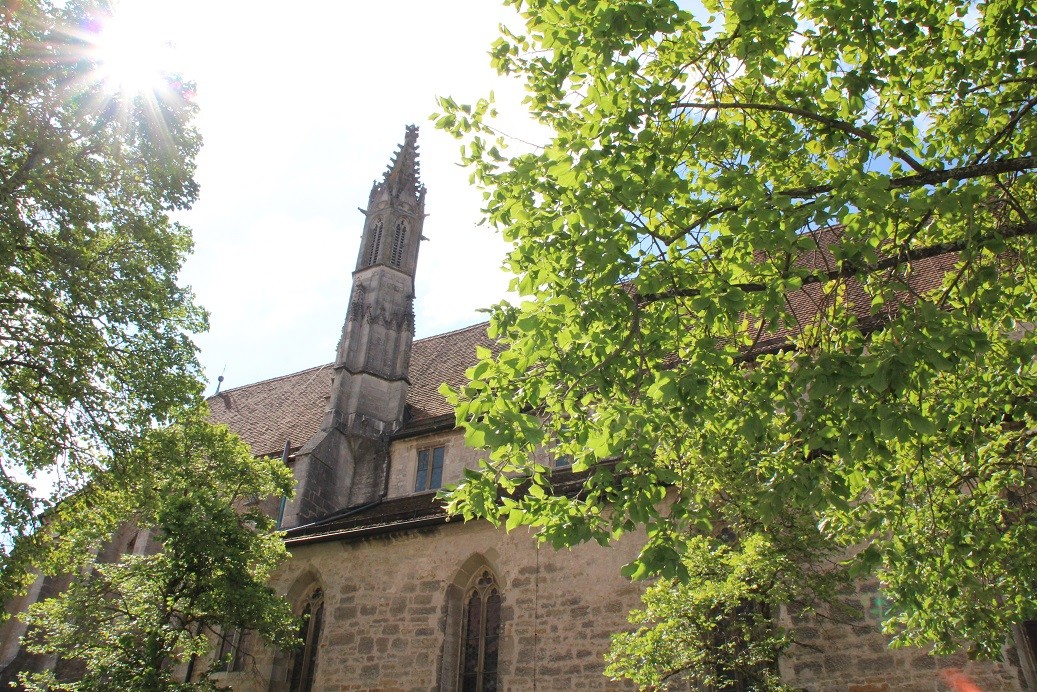Let's go
we recommend taking the tour on foot
Welcome to Rothenburg ob der Tauber – a place that seems straight out of a fairytale.Immerse yourself in the winding alleys, admire the picturesque half-timbered houses, and feel the century-old history of this unique city. On this tour, you'll discover the highlights of Rothenburg from an entirely new perspective. Let yourself be enchanted by the stories, secrets, and the distinctive atmosphere of this historical gem.
this tour was created by the Tourism Service Rothenburg
Introduction
DE
Town Hall & Market Square
The Town Hall of Rothenburg ob der Tauber dominates the west side of the market square. Inside, along with the mayor's office and the city's administration offices, you'll find the Great Council Hall, now known as the Kaisersaal. This hall represents an important part of Rothenburg's political ambitions under Mayor Heinrich Toppler, which began to emerge in the late 14th century. In the past, the Kaisersaal was used for ceremonial purposes and as a courtroom, but nowadays, during Pentecost, the Historical Festival Play takes place there.
Insider tip: With our 3D tour, you can explore the Kaisersaal. For those who want to reach new heights, the town hall offers a climb: 220 steps lead you to the top of the town hall tower - the view up there is gigantic.
DE
EN
The Little Square "Plöhnlein"
Insider Tip: The Plönlein is a true global star!
Whether in a Justin Bieber music video or in Pinocchio – this magical place is featured.
DE
EN
The Markus Tower
We are standing in front of the original city wall of Rothenburg ob der Tauber. The lane called Alter Stadtgraben, which branches off here, has its name for a reason. The houses actually stand on what was once the moat. The Röder Archway was once the entrance to the city. The Markusturm has been here much longer, serving as an advanced observation tower for the nearby Stauferburg.
Insider Tip: Later, the Markus Tower was integrated into the city defense and, in addition to the Büttelhaus, also served as the city prison.
DE
EN
The Medieval Crime Museum
We are standing in front of the former Johanniter Commandery in Rothenburg ob der Tauber. Today, you're visiting the exhibition of the Medieval Crime Museum here. Europe's largest legal museum takes you on a journey through time. How was justice administered in earlier times? Important highlights include the torture instruments in the cellar of the former Johanniter Commandery, as well as the shame masks and the section on the death penalty.
Insider tip: No, the baker's baptism is not about an ancient machine for baking bread. The cage in the courtyard of the Crime Museum represents a form of public shaming: If a baker cheated with the ingredients and was convicted, he would be placed in the cage and dunked in water (or worse).
DE
EN
The Rothenburg Museum
Once a monastery, now the city museum. The Dominican nuns from Neusitz arrived in Rothenburg at the former manor in 1258. Lupold von Nordenberg, a nobleman from the region and the official imperial kitchen master, had donated the estate. The nuns hailed from the rural nobility of the area. As a dowry, they brought rural properties such as vineyards, forests, or fish ponds into the possession of the monastery. In Rothenburg, the monastery's grounds were like a kingdom of its own within the city limits.
Insider tip: In the past, disputes between the city and the monastery were decided by the Emperor or King. Nowadays, the {{Rothenburg Museum}} is located here.
DE
EN
Jews' Lane
The Judengasse in Rothenburg ob der Tauber is located in the Klingen District. It is considered the oldest continuous Jewish residential street. The first Jewish community settled at Kapellenplatz right next to the market square. As the name suggests, primarily the Jewish population lived in the Judengasse just outside the first city wall, and thus extra muros. However, one should not understand the Judengasse as a closed quarter. The Jewish Dance House at the White Tower served as the community center for the Jewish community at that time.
Insider tip: At Judengasse 12, you'll find a historical mikveh. This is a Jewish ritual bath used for achieving ritual purity through immersion. The resulting hygiene was a positive health benefit.
DE
EN
St. James's Church
St. Jakob's Church is the successor of a church and a chapel from the second half of the 12th century. As a city church, it has shaped the silhouette of Rothenburg from afar for centuries. The Gothic church stands out with its two towers. Interestingly, they are built differently: one is taller, while the other has thicker walls. Inside, you'll find two famous altars, true masterpieces. Take a closer look: The main altar is the Twelve Apostles Altar by Friedrich Herlin. On it, you can see the oldest depiction of the marketplace from the 15th century. Even more impressive is the Holy Blood Altar by Würzburg artist Tilman Riemenschneider. The unique feature is that the relic from the church's Catholic era still stands in the Protestant city church today - it was never removed from the church.
Insider tip: St. Jakob is the name of the city church - that should definitely catch the attention of the pilgrim enthusiasts among you. Yes, Rothenburg ob der Tauber is located on the Jakobsweg, which has become more famous than ever since the book by Hape Kerkeling! The shell on the ground doesn't lead you to the well-known gas station brand but rather points you in the right direction towards Santiago de Compostela, where the Jakobsweg ends. The shell is the symbol of the Jakobsweg pilgrims.
DE
EN
The Käthe Wohlfahrt Christmas Museum
Käthe Wohlfahrt's Christmas Museum shines a spotlight on the origins of traditions surrounding the joyful holiday season. Where did the idea for the Christmas tree come from? What's the story behind the nutcracker as an instrument of Prussian propaganda? And how did Coca-Cola hijack the beloved Santa Claus and turn him into a commercial figure? Additionally, the museum delves into the origins of German glass globe production and wood carving craftsmanship: the journey takes us to the Ore Mountains in Saxony, to the roots of the Wohlfahrt family. They continue to run the world's largest specialist retailer for Christmas decorations to this day and have created a festive experience world with the Christmas Village beneath the museum.
DE
EN
The Franciscan Church
Here it gets spooky - we're standing in front of the Franziskaner Church on Herrngasse. Many nobles and members of leading Rothenburg families had their family burial sites here. This was by no means unique to Rothenburg, as the Franciscan order has always had close ties to urban populations in other regions as well. Parts of the Franciscan complex were demolished starting in 1841, as they had been auctioned off for demolition. Later, the complex in Rothenburg was used by the Goethe-Institut. The Argentine Pope Francis spent several months here in the 1980s learning German. Most recently, the site was used for a school.
Insider Tip: In the Franciscan Church, you can still find an original wooden rood screen - historically, such a screen separated the laypeople from the monks in churches. The fact that the original is still preserved here makes the Franciscan Church truly special. Often, biblical stories were depicted in images on rood screens. Many laypeople could not read or understand Latin, but they could grasp the Christian messages through these images.
DE
EN
